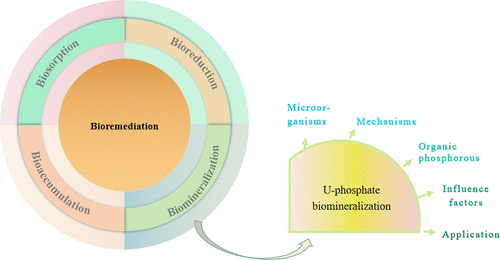当前位置:
X-MOL 学术
›
ACS Earth Space Chem.
›
论文详情
Our official English website, www.x-mol.net, welcomes your
feedback! (Note: you will need to create a separate account there.)
Uranium Biomineralization with Phosphate—Biogeochemical Process and Its Application
ACS Earth and Space Chemistry ( IF 2.9 ) Pub Date : 2020-12-03 , DOI: 10.1021/acsearthspacechem.0c00252 Dan Zhang 1, 2 , Xue Chen 1, 2 , Steven L. Larson 3 , John H. Ballard 3 , Heather M. Knotek-Smith 3 , Dexin Ding 2 , Nan Hu 2 , Fengxiang X. Han 1
ACS Earth and Space Chemistry ( IF 2.9 ) Pub Date : 2020-12-03 , DOI: 10.1021/acsearthspacechem.0c00252 Dan Zhang 1, 2 , Xue Chen 1, 2 , Steven L. Larson 3 , John H. Ballard 3 , Heather M. Knotek-Smith 3 , Dexin Ding 2 , Nan Hu 2 , Fengxiang X. Han 1
Affiliation

|
Anthropogenic activities involving uranium mining, nuclear fuel processing, nuclear weapon production, or nuclear power plant accidents have polluted soil and groundwater. As a byproduct of the uranium enrichment process for nuclear energy production, depleted uranium metal is available for use in a number of non-energy applications. Many of these uses cause a distribution of uranium metal, soluble uranium species, and oxides in the environment. A number of restoration techniques have been developed. One remedial approach is in situ biomineralization of U to form highly stable and insoluble U mineral products in soils and sediments. This review covers the current research status of uranium biomineralization using phosphate. The biogeochemical processes, biomineralization mechanisms, and biogeochemical conditions associated with the formation of uranium phosphate minerals were reviewed. This overview may be used to facilitate the further development and optimization of in situ bioremediation strategies for uranium in environmental systems.
中文翻译:

磷酸铀生物矿化—生物地球化学过程及其应用
涉及铀矿开采,核燃料加工,核武器生产或核电站事故的人为活动污染了土壤和地下水。作为用于核能生产的铀浓缩过程的副产品,贫化铀金属可用于许多非能源应用。这些用途中的许多用途导致环境中铀金属,可溶性铀物质和氧化物的分布。已经开发了许多恢复技术。一种补救方法是就地铀的生物矿化作用,在土壤和沉积物中形成高度稳定且不溶的铀矿产品。这篇综述涵盖了使用磷酸盐进行铀生物矿化的研究现状。综述了与磷酸铀矿物质形成有关的生物地球化学过程,生物矿化机理和生物地球化学条件。该概述可用于促进环境系统中铀的原位生物修复策略的进一步开发和优化。
更新日期:2020-12-17
中文翻译:

磷酸铀生物矿化—生物地球化学过程及其应用
涉及铀矿开采,核燃料加工,核武器生产或核电站事故的人为活动污染了土壤和地下水。作为用于核能生产的铀浓缩过程的副产品,贫化铀金属可用于许多非能源应用。这些用途中的许多用途导致环境中铀金属,可溶性铀物质和氧化物的分布。已经开发了许多恢复技术。一种补救方法是就地铀的生物矿化作用,在土壤和沉积物中形成高度稳定且不溶的铀矿产品。这篇综述涵盖了使用磷酸盐进行铀生物矿化的研究现状。综述了与磷酸铀矿物质形成有关的生物地球化学过程,生物矿化机理和生物地球化学条件。该概述可用于促进环境系统中铀的原位生物修复策略的进一步开发和优化。










































 京公网安备 11010802027423号
京公网安备 11010802027423号